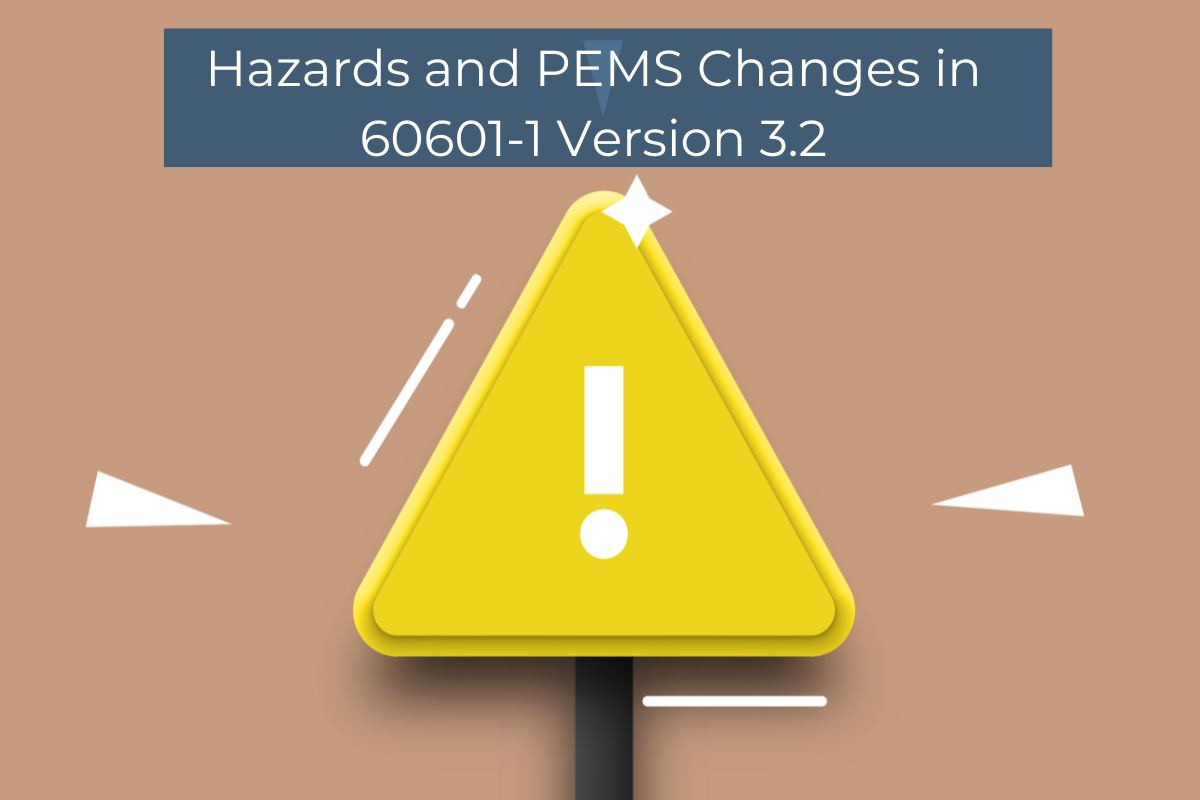Revisions made to Hazardous Situations & Fault Conditions and PEMS: 60601-1 Version 3.2
The general standards applied to medical electrical (ME) systems and equipment, IEC 60601-1, was updated in August 2020. Amendment 2 to Version 3 was already recognized by the FDA and goes into effect for devices in production set to launch on or after December 17, 2023. If you’re a manufacturer looking to get clearance, you need to know about the changes to this standard, which include 78 items out of the 109 proposed. These items were seen as being too urgent to wait for a Version 4 release.
While there are revisions and changes throughout the standard, some of the sections that received the most major updates include:
- Clause 2 (Normative References)
- Clause 3 (Terminology & Definitions)
- Clause 7 (Identification and Marking)
- Clause 8 (Protection Against Electrical Hazards)
- Clause 11 (Protection Against Excessive Temperatures and Other Hazards)
- Clause 13 (Hazardous Situations and Fault Conditions)
- Clause 14 (Programmable Electrical Medical Systems (PEMS)
This blog goes through what’s new in Clause 13 and Clause 14 of IEC 60601-1 3.2.
Changes to Clause 13 – Hazardous Situations and Fault Conditions
The most major change in this clause was the language around excessive temperatures on the list of hazardous situations that should not occur (13.1.2). Accessible parts that have a likelihood of being touched, but don’t need to be touched or should be touched to operate the ME equipment, shouldn’t exceed the temperature limits listed on Table 34.
The maximum temperatures listed on Table 34 vary based on the material the external surface is made of and is based on the assumption that they will be touched for 1 second or less. The range goes from 80 degrees Celsius for metal and liquids to 150 degrees Celsius for wood.
For accessible parts that are meant to be touched to operate the ME equipment, Amendment 2 references Table 23 for temperature limits. The table is divided by material and the duration that the external surface is likely to be touched, ranging from under 1 second to greater than or equal to 1 minute. Guidance on the table refers to contact that involves smaller areas of skin being touched, less than 10% of the body surface.
A note has been added on single-fault conditions and secondary circuits under this section as well: “When the investigated part of the supply circuit is a battery, the limit for the power dissipation is considered directly on the output contacts of the battery supply circuit, even before an external protective device.”
A few adjustments were also made to the section on the conditions secondary circuits need to meet:
- They need to be mounted on a material with a V-1 flammability classification
- They need to be energized at a 42.4 V peak, 60 V d.c. or less when in single fault or normal conditions
- In single-fault conditions, they need to be limited to less than 100 VA or 6,000 J
- Wire insulation guidance hasn’t changed and includes the following types: TFE, PVC, FEP, PTFE, polybromide, and polychloroprene
Secondary circuit compliance can be checked in one of two ways:
- If an electronic circuit provides protection, draw 100 volt-amps (VA) from the supply circuit for 5 seconds after applying the load
- For positive temperature coefficient devices, or in other cases not covered by the first point, draw 100 VA from the supply circuit for 60 seconds
If 100 VA is not supplied by the circuit after 5 seconds or 1 minute, depending on the situation, “the circuit should be considered to limit power dissipation to less than 100 VA.” Design documentation would also be reviewed for compliance in this case.
Changes to Clause 14 – Programmable Electrical Medical Systems (PEMS)
In Clause 14, the main update included a definition of SOUP (software of unknown provenance) as referenced in IEC 62304:2006/AMD1:2015.
Software that applies under SOUP was not specifically developed for medical devices. It already existed prior to the ME device development and is “generally available.” It might also be known as “off-the-shelf software.” This can also apply to software that doesn’t have available and adequate records of the development process.
Throughout Clause 14, additional references have been included:
- IEC 62304:2006/AMD1:2015
- Subclauses 4.3 and 4.4
- Annex C of ISO 14971:2019
What should manufacturers do in response to changes with Hazards and PEMS in 60601-1 3.2?
If you are a manufacturer looking to get your ME system or equipment cleared on or after December 17, 2023, you need to be sure that all components you include meet the standards outlined in Version 3.2. RAM Technologies’ PC PSUs meet the requirements of IEC 60601-1 3.2 and are currently certified, giving you one less item to think about. To learn more about our compliant PSUs, reach out to us today.
________________________
RAM Technologies’ power supplies are 60601-1 3.2 certified and meet 60601-1-2 EMC standards. When you’re designing your medical device and need help with a PSU, contact us for details.



